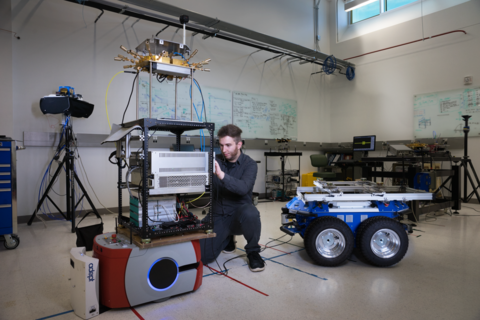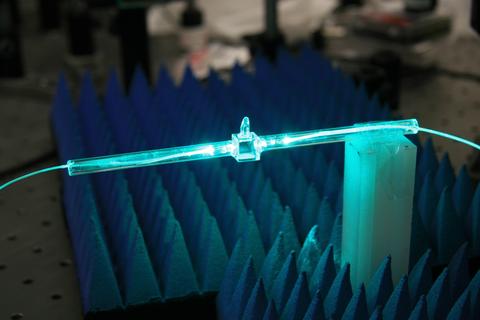Electromagnetic Fields Group
The Electromagnetic Fields Group conducts theoretical and experimental research necessary for the accurate measurement of free-space electromagnetic field quantities; for the characterization of antennas, probes and antenna systems; for the development of effective methods for electromagnetic compatibility assessment; for the measurement of radar cross section and radiated noise; and for providing measurement services for essential parameters.

The Electromagnetic Fields Group measures, characterizes, and calibrates antennas and radiated fields of the type used in many high-performance communication, defense, aerospace, satellite, and wireless systems.
The Electromagnetic Fields Group has a long heritage in advancing the understanding of radio frequency behavior. Today our major focus is on developing new ways to characterize next-generation 5G wireless communications systems. The RF Fields Group faces new challenges as new spectrum bands in the tens and even hundreds of gigahertz (GHz) open up and as new types of modulation come into play (such as the spatial modulation with massive MIMO). We’ve responded by inventing new ways to quickly characterize, measure and test these millimeter wavelengths.
MAJOR PROJECTS
ANTENNA METROLOGY PROJECT
Antenna parameter measurements are necessary to accurately characterize radiating systems. The mission of the Antenna Metrology Project is to provide world’s best antenna parameter measurements from 1 GHz to 500 GHz to enable next generation communications systems, to support defense systems for national security, to advance basic antenna metrology research, and to support external customers.
Following the tradition to pioneer new measurement techniques, the Antenna Metrology Project developed the Configurable Robotic MilliMeter-wave Antenna facility (CROMMA) and the Large Antenna Positioning System (LAPS) facilities, which use robotic arms to position the antenna and near field probe for near field scans. Along with the development of modern near field numerical methods, and machine vision alignment techniques, CROMMA and LAPS allow for arbitrary scan geometries, irregular measurement sampling grids, and larger datasets.
Recently, the Antenna Metrology Project adapted the LAPS system to support the emergence of 5G communications systems and the commercialization of millimeter-wave phased array antennas. Measurement and characterization of these integrated phased array communications systems is more complicated than the measurement techniques developed for their DoD predecessors. The agility of LAPS is based on a dual robotic arm system. Along with a Coherent Receiver System, machine vision assisted alignment, and new near field numerical methods, LAPS will provide the measurements required to characterize the wider channels, digitally-formed signals, moving or steered antennas, and MIMO configurations of 5G communications systems.

FIELD STRENGTH METROLOGY PROJECT
Radio frequency (RF) field strength measurements are necessary to accurately characterize radiating systems. The mission of the RF Field Strength Metrology Project is to provide world’s best field strength measurements from 100 kHz to 1 THz, to advance basic field strength metrology research, and to support external customers. NIST calibrates electrically-small field probes from 10 megahertz – 40 gigahertz in Transverse Electromagnetic (TEM) cells and a fully anechoic chamber, as part of the Electromagnetic Field Strength Metrology Project.
The Field Strength Metrology Project is building a first-of-its-kind quantum-field antenna probe that uses Rydberg atoms excited by lasers produce an electromagnetic transparent probe to measure field strength with SI Traceability. The Rydberg atom-based probe acts as a compact receiver antenna that can lead to the development of a quantum based receiver that measures amplitude, phase and polarization of modulated electric fields over a frequency range from MHz to THz. This is a fundamentally new approach to radio frequency metrology, one that promises to improve the sensitivity, precision, and ease of tests and calibrations of high-frequency field probes used for measuring radiated fields in next-generation 5G wireless systems, biomedical, and nanoelectronic systems, and environmental and other sensors.
CHANNEL SOUNDER METROLOGY
To meet the needs for 5G advanced communication a more-complete understanding of the RF propagation channel is desirable. NIST is verifying channel sounders’ Power Delay Profile performance for a variety of architectures under the channel-sounder verification program launched in the context of the 5G mmWave Channel Model Alliance. This verification process has led to the development of calibration techniques and measurement science that provides a better understanding of the complex environment and propagation conditions of channel-sounder systems. This effort supports the development of accurate channel propagation measurements and models, which lead the standard specifications development cycle at 3GPP and IEEE.
FACILITIES/TOOLS
Quantum Field Antenna Probe Laboratory
Antenna and Communication Metrology Laboratory
Configurable Robotic MilliMeter-wave Antenna facility (CROMMA)
Large Antenna Positioning System
Contacts
Group Leader
-
(303) 497-6184

